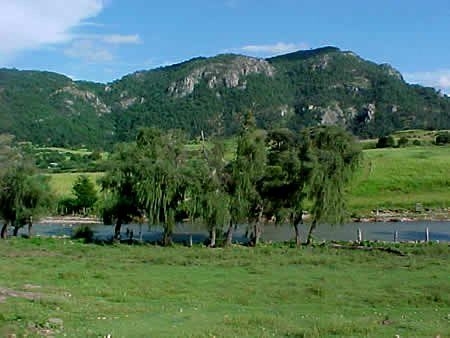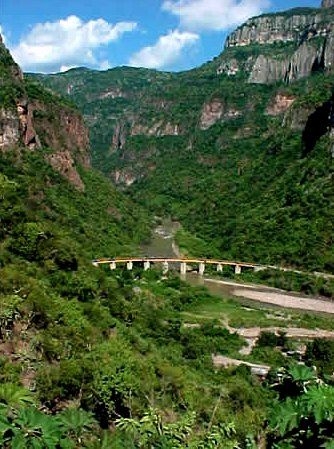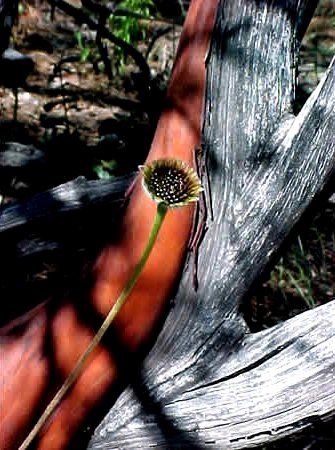Waking with the dawn and watching the sun invade the horizon from a perch on a clifftop at the highest point of the Chihuahua Pacific railroad (El Chepe) in the Copper Canyons of Mexico was an unforgettable experience. The night before (see the previous post), we had watched the sun slide behind the crags and mountaintops, drawing a curtain upwards along the cliff faces until they were obscured by the mysterious deep dark of a sky devoid of the slightest hint of light pollution.
On day two of our Copper Canyon adventure, I watched the sun arise and gradually tinge the edges of the canyons with filaments of light that grew to fill the dome above with ever-brightening hues. The crispness of the early-morning air bit into my skin as I sat on the terrace outside our room sipping hot coffee, wrapped in my warmest shawl. Hummingbirds whirred through the gardens around me and disappeared over the cliff edges, searching for nectar.
Our plan for the day was to take another walking tour after breakfast to see the high-elevation vegetation and take in some more spectacular canyon views and cliff formations in the opposite direction from our walk of the previous afternoon. We were guided by one of the local Tarahumara guides, who pointed out trees and bushes, giving us their local names and medicinal uses, and told us stories of his people, the runners. He led us along well-traveled paths to the edges of precipitous canyons; we were approached by taciturn, vibrantly-dressed women and children selling crafts of straw and fabric and were astounded by the deep chasms that rolled and sometimes dropped away to unfathomable depths below us. I was glad that many of the clifftops were protected by sturdy, wooden handrails.
Returning to Divisadero at midday, we checked out of the Divisadero Barrancas hotel and made our way back to the train station to await the train coming from Chihuahua and head back toward the coast. It would take us back to the Bahuichivo station, where we hoped to find transportation to the town of Cerocahui, a gateway to the Urique Canyon. The station was abuzz with activity: tourists waiting for the train, vendors (again, mainly women and children) pushing their wares, and a number of food stands selling corn gorditas stuffed with savory combinations of cheese, mushrooms, meat, and vegetables. The gorditas were irresistible.
It was a short train ride back from Divisadero to the Bahuichivo station. As we descended from the train, we spotted a small bus waiting to one side of the station, marked with the name the Hotel Mission in Cerocahui. The driver consented to let us ride with the other passengers (three women friends who had traveled from Mexico City) going to the hotel, as long as we agreed to look at the hotel and consider staying there that night, since the bus was not allowed to carry regular passengers. Little did we know then that it was the only hotel in town. It turned out to be an easy sale.

Once installed in the hotel, we ventured out into the town and valley in which it was nestled. Cerocahui was small and basic, but somewhat more of a town than Divisadero was: Unpaved streets, a Tarahumara girl’s boarding school, a beautiful old church, the Mission hotel, a town plaza, a couple of stores, and a few dozen simple houses and other structures scattered in a high meadow alongside a rushing stream.
We asked about places to eat other than the hotel restaurant and were directed to a private home. The owner ushered us inside and settled us at her dining room table. She offered us a simple, home-cooked meal from her own kitchen, which she heated for us as we admired the brilliant flower blossoms in her garden and the multitude of quartz crystals she had collected. Many of the large crystal conglomerations served as planters, with lush plants growing seemingly out of the bare rock. She proudly showed us how her house was wired for solar electricity, explaining that the only other source of electricity they had in the town was a generator down at the stream that was turned on only from 7 to 9 o’clock every morning and evening. Solar was the way to go.
We spent a quiet evening back at the Hotel Mission (I don’t think there is any other kind of evening available in Cerocahui!), had a restful sleep (kept barely warm by a small fire for the first part of the night, anyway), and were up bright and early for breakfast. The hotel served some heavenly home-baked breads and homemade jams. We had several hours to kill before catching the train back to El Fuerte from Bahuichivo station, so we signed up for a horseback ride along trails that took us through lovely fields and vales, following a stream to a beautiful waterfall.
We left Cerocahui around midday, boarded the train bound for El Fuerte, and snaked our way again through the draws and canyons toward the Pacific coast. We pulled into El Fuerte just in time for a dramatic rainy season sunset.
A trip into the Copper Canyon is well worth the effort. If you want to do the whole canyon and have ample time for hikes and walks, plan on a week or ten days. Although we “winged it” and didn’t make advance reservations for train or hotel, we did make our trip several years ago and in the slowest of all seasons. Security is more of a consideration these days, and unless you carry camping equipment, you could find yourself without accommodations or transport in a very remote and chilly part of Mexico. I recommend booking a package tour or at least reserving hotels and train passages in advance through the Internet.







